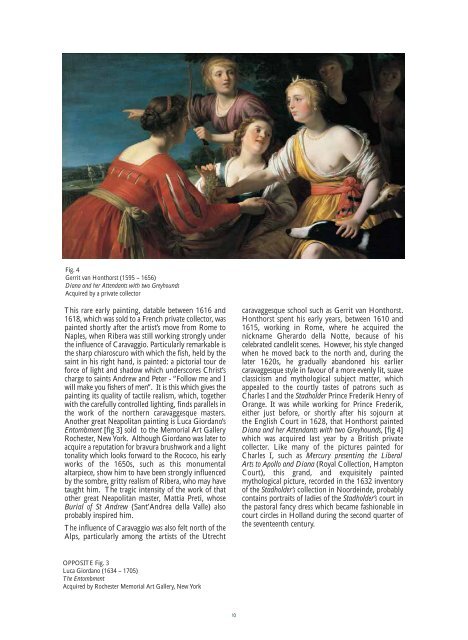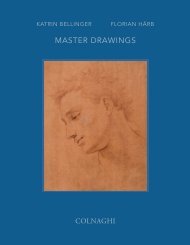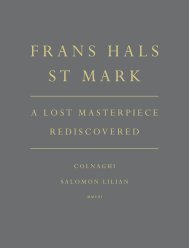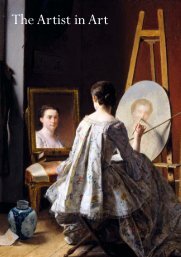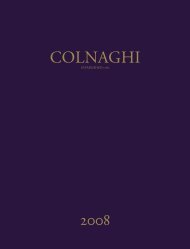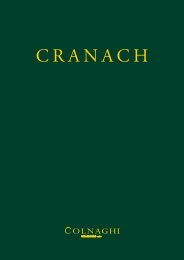2007 Catalogue - Colnaghi
2007 Catalogue - Colnaghi
2007 Catalogue - Colnaghi
Create successful ePaper yourself
Turn your PDF publications into a flip-book with our unique Google optimized e-Paper software.
Fig. 4<br />
Gerrit van Honthorst (1595 – 1656)<br />
Diana and her Attendants with two Greyhounds<br />
Acquired by a private collector<br />
This rare early painting, datable between 1616 and<br />
1618, which was sold to a French private collector, was<br />
painted shortly after the artist’s move from Rome to<br />
Naples, when Ribera was still working strongly under<br />
the influence of Caravaggio. Particularly remarkable is<br />
the sharp chiaroscuro with which the fish, held by the<br />
saint in his right hand, is painted: a pictorial tour de<br />
force of light and shadow which underscores Christ’s<br />
charge to saints Andrew and Peter - “Follow me and I<br />
will make you fishers of men”. It is this which gives the<br />
painting its quality of tactile realism, which, together<br />
with the carefully controlled lighting, finds parallels in<br />
the work of the northern caravaggesque masters.<br />
Another great Neapolitan painting is Luca Giordano’s<br />
Entombment [fig 3] sold to the Memorial Art Gallery<br />
Rochester, New York. Although Giordano was later to<br />
acquire a reputation for bravura brushwork and a light<br />
tonality which looks forward to the Rococo, his early<br />
works of the 1650s, such as this monumental<br />
altarpiece, show him to have been strongly influenced<br />
by the sombre, gritty realism of Ribera, who may have<br />
taught him. The tragic intensity of the work of that<br />
other great Neapolitan master, Mattia Preti, whose<br />
Burial of St Andrew (Sant’Andrea della Valle) also<br />
probably inspired him.<br />
The influence of Caravaggio was also felt north of the<br />
Alps, particularly among the artists of the Utrecht<br />
OPPOSITE Fig. 3<br />
Luca Giordano (1634 – 1705)<br />
The Entombment<br />
Acquired by Rochester Memorial Art Gallery, New York<br />
10<br />
caravaggesque school such as Gerrit van Honthorst.<br />
Honthorst spent his early years, between 1610 and<br />
1615, working in Rome, where he acquired the<br />
nickname Gherardo della Notte, because of his<br />
celebrated candlelit scenes. However, his style changed<br />
when he moved back to the north and, during the<br />
later 1620s, he gradually abandoned his earlier<br />
caravaggesque style in favour of a more evenly lit, suave<br />
classicism and mythological subject matter, which<br />
appealed to the courtly tastes of patrons such as<br />
Charles I and the Stadholder Prince Frederik Henry of<br />
Orange. It was while working for Prince Frederik,<br />
either just before, or shortly after his sojourn at<br />
the English Court in 1628, that Honthorst painted<br />
Diana and her Attendants with two Greyhounds, [fig 4]<br />
which was acquired last year by a British private<br />
collecter. Like many of the pictures painted for<br />
Charles I, such as Mercury presenting the Liberal<br />
Arts to Apollo and Diana (Royal Collection, Hampton<br />
Court), this grand, and exquisitely painted<br />
mythological picture, recorded in the 1632 inventory<br />
of the Stadholder’s collection in Noordeinde, probably<br />
contains portraits of ladies of the Stadholder’s court in<br />
the pastoral fancy dress which became fashionable in<br />
court circles in Holland during the second quarter of<br />
the seventeenth century.


